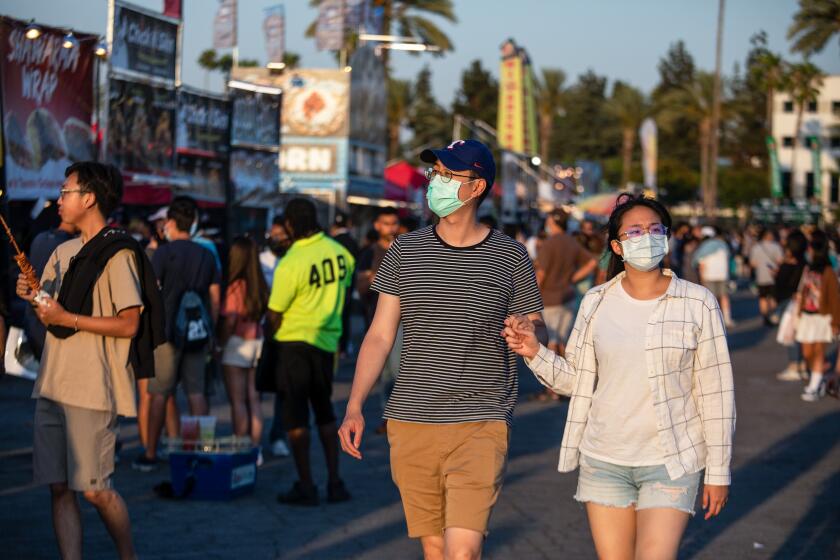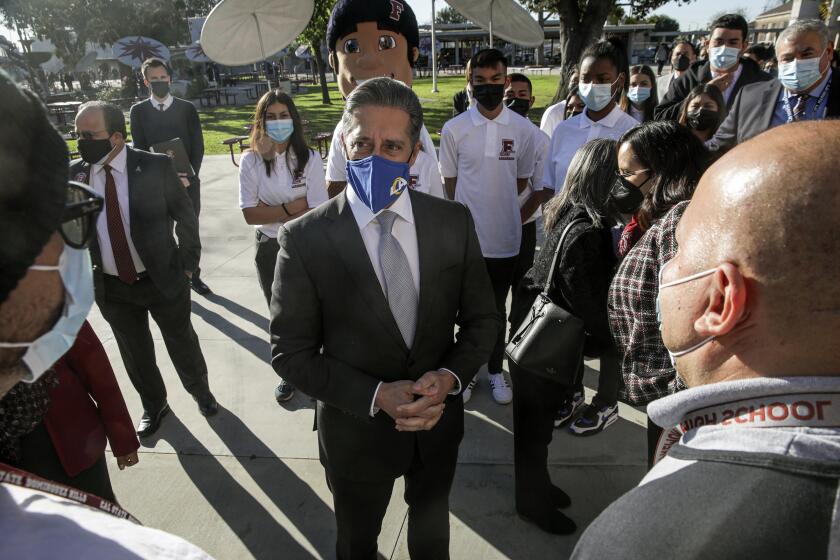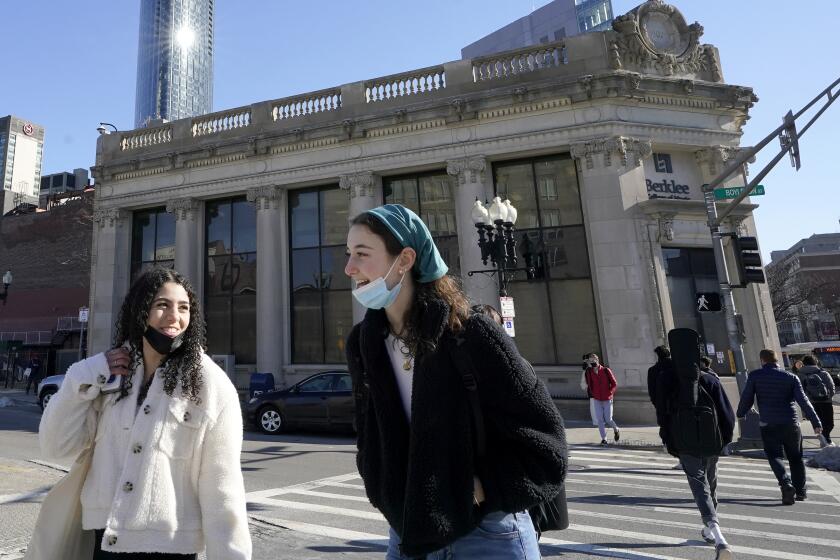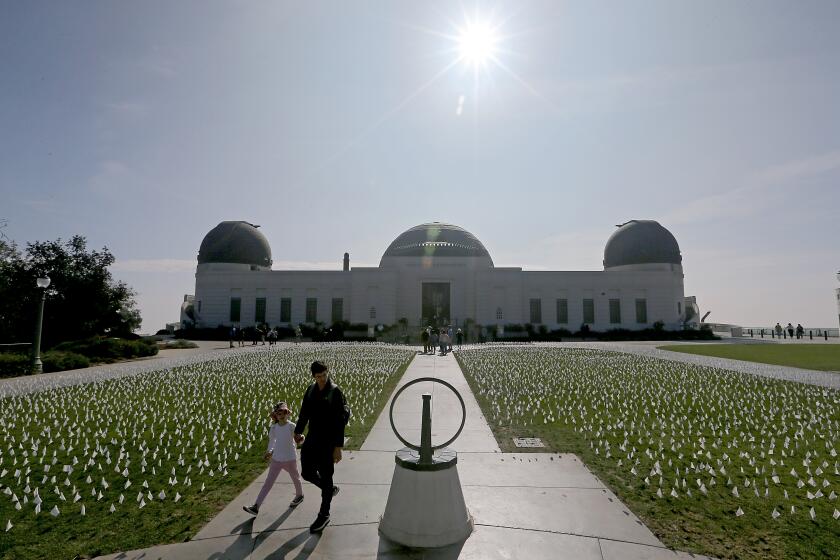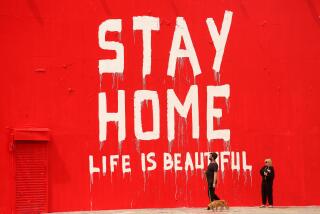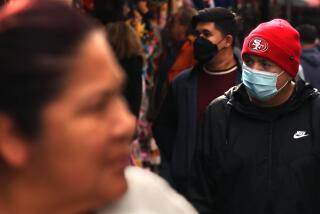California offers cautious blueprint forward as COVID wanes, mask orders ease

- Share via
California officials on Thursday offered a cautious blueprint for the next phase of the pandemic, expressing optimism at the progress that has been made but stressing the state must be prepared for the potential for new variants and waves.
The plan comes amid a growing push in some quarters to finally move on from two years of restrictions due to the coronavirus. While mask mandates have been easing, state officials essentially said that it’s unwise to fly a “mission accomplished” banner and that the most important thing now is to be prepared for any contingencies — and to learn from past lessons.
“Today is not about moving on but, rather, about moving forward,” California Health and Human Services Secretary Dr. Mark Ghaly said. “We move into this next phase with humble confidence and a commitment to be active and aware every step of the way. We move into the next phase smarter than we ever have been.”
That means being prepared for a bump in coronavirus cases as the school year begins in the late summer, and a higher surge just as next winter gets underway, officials said. It also means there may be instances when universal indoor mask orders are needed for periods of time to avoid overwhelming hospitals and ambulances responding to 911 calls.
The plan calls for stockpiling a robust supply of masks, maintaining the capacity to administer hundreds of thousands of vaccine doses and coronavirus tests per day, and enhancing the ability to track COVID-19 trends and respond to hard-hit communities. It’s now clear that there will need to be a years-long fight against COVID-19.
On Wednesday, state health officials lifted a requirement that all residents age 2 and older wear masks in most indoor public spaces.
Speaking from a warehouse in Fontana on Thursday, Gov. Gavin Newsom said, “we recognize with humility that we don’t know what we don’t know as it relates to the future, but we have never been more prepared for that future.”
“It’s in that spirit of optimism that we now move into a new phase of addressing the challenges and realities of this disease,” he said. “We move out of the pandemic phase and we move into a phase which should allow you confidence that we are not walking away, that we’re taking the lessons learned and we’re leaning into the future.”
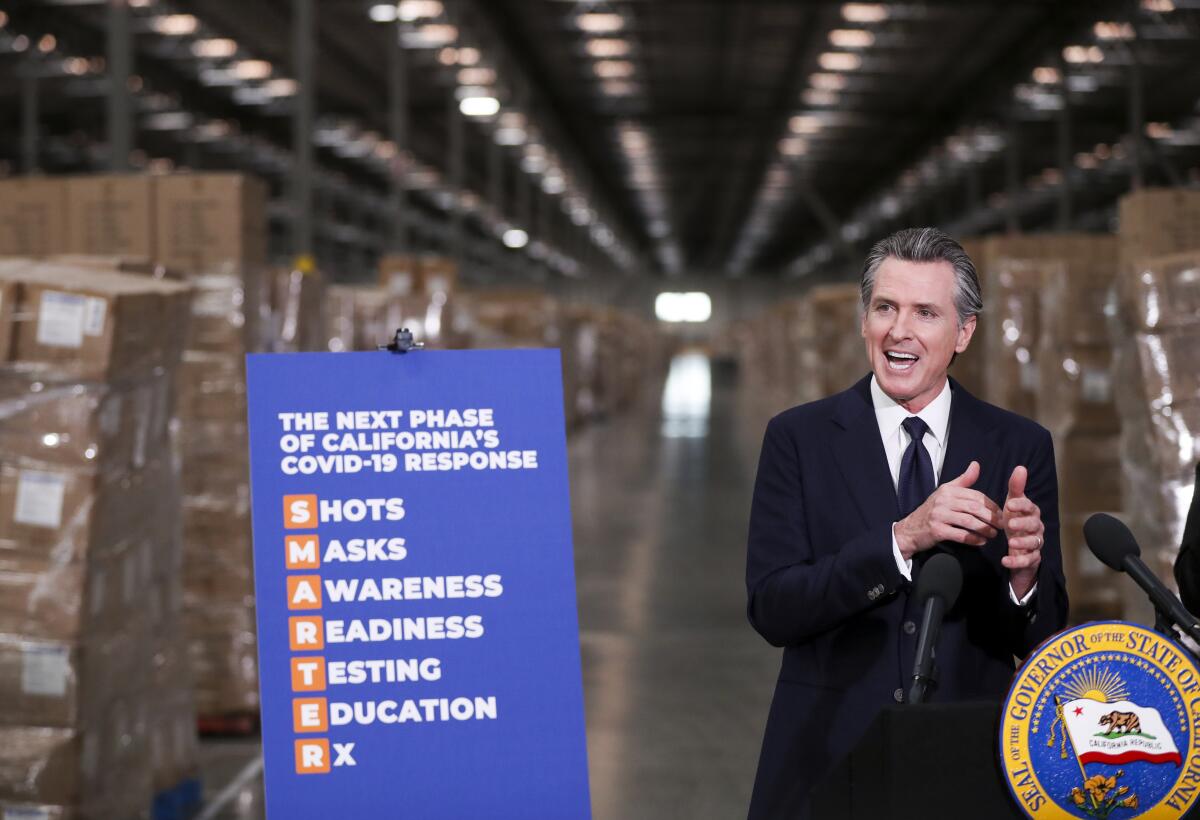
The unveiling of the new plan comes as authorities remain upbeat about continued plunges in coronavirus cases and hospitalizations, and reiterated they could be prepared to ease additional restrictions, such as the indoor mask mandate in K-12 schools, in a matter of weeks. Newsom said plans are in place to announce by Feb. 28 a specific date to ease that order.
“The date will be well within a period of time that, I think, will do justice to the needs to keep people confident that their children are being prioritized and healthy and safe; at the same time, to accommodate the understanding that we’re trying to promote today that we are moving into a new phase of this pandemic,” Newsom said.
On Wednesday, the state lifted a two-month-old mask order for vaccinated people in many indoor public spaces, with only a handful of areas — Los Angeles, Santa Clara and Mendocino counties, and Palm Springs — retaining local versions of those orders, likely for a few more weeks. Unvaccinated people are still required to wear masks indoors statewide, and universal mask orders still apply in settings like nursing homes and on public transportation.
Many health experts are strongly recommending the public still wear masks even as the state lifted its order requiring them to be worn in indoor public spaces for vaccinated people.
Even as California officials have dropped an indoor mask mandate statewide for settings such as stores, restaurants and gyms, Ghaly and other health officials have suggested there may come a time when it might be appropriate to reimplement mask orders to keep hospitals from becoming overwhelmed again.
“The fact that masks work should not be the debate,” Ghaly said. “We should work together to make sure those who benefit most have access to the highest-quality masks we can provide. And at times there may need to be a time when we all wear masks to get through certain situations, so we don’t overwhelm our healthcare delivery system.”
Ghaly’s comments echoed those made by Dr. Rochelle Walensky, director of the U.S. Centers for Disease Control and Prevention, on Wednesday: “We want to give people a break from things like mask wearing, when these metrics are better, and then have the ability to reach for them again should things worsen.”
“I know that everyone is anxious to move beyond this pandemic and some of the ways we have had to change the way we live over the last two years,” she said during a briefing. “We all share the same goal: to get to a point where COVID-19 is no longer disrupting our daily lives; a time when it won’t be a constant crisis, rather something we can prevent, protect against and treat.”
New L.A. Unified schools chief said he is conferring with medical experts and expects an announcement soon.
Ghaly didn’t lay out a specific plan Thursday for when masks might be required again in indoor public settings but outlined a four-tier system for telegraphing the urgency by which masks should be recommended or required — the lowest urgency level defined as masks being optional, then going up to a recommendation, a strong recommendation, then a requirement.
The metrics by which California might have to reinstitute mask mandates or otherwise respond to a potential new variant will depend on the new strain itself. A particularly deadly variant might require a focus on preventing new cases, Ghaly said. But a less virulent virus, even one that is more transmissible, may result in more attention to hospitalization rates.
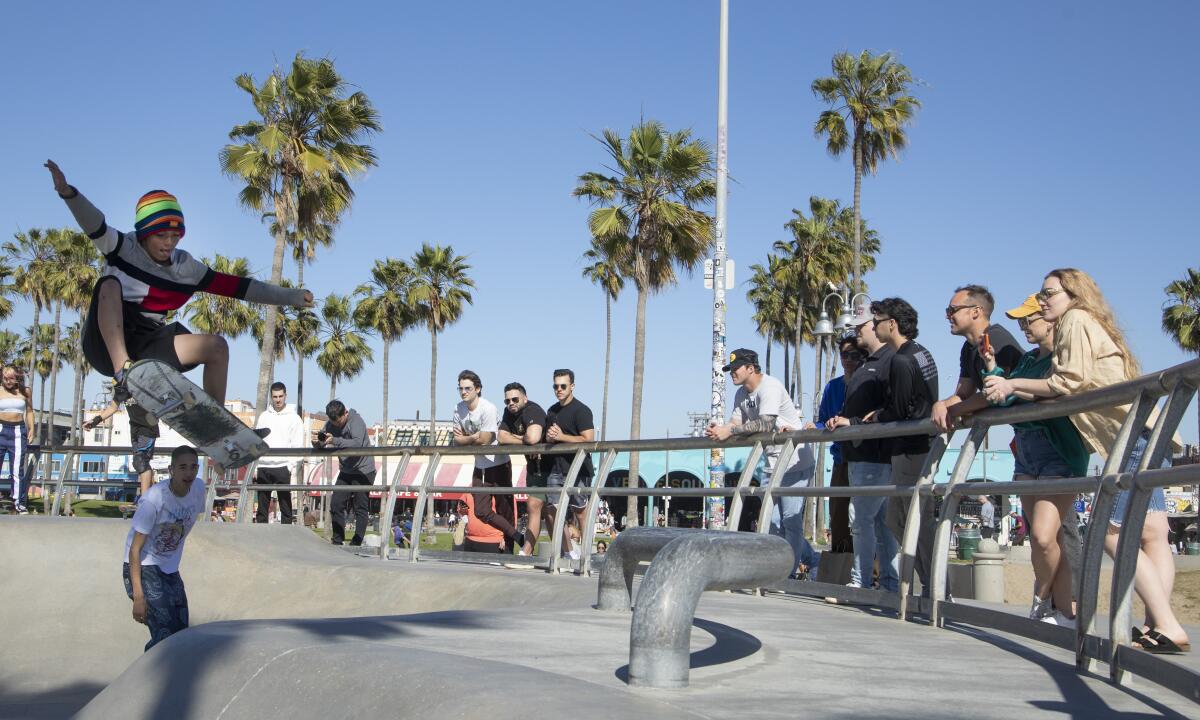
Ghaly has said the state is strongly recommending masks still be worn in indoor public settings. “For some, the strong recommendation that we currently have should be heeded as the time to use a high-quality, high-filtering mask as a life-saving tool — those with underlying conditions, those who are immunocompromised, those who can’t yet for one reason or another be vaccinated.”
The acronym “SMARTER” represents the approach outlined in the state plan, which is anchored around seven key areas: shots, masks, awareness, readiness, testing, education and Rx (or anti-COVID drugs).
Included in the 30-page document are specific benchmarks. Among them are ensuring the capacity to administer at least 200,000 vaccines and 500,000 tests a day, as well as stockpile of 75 million high-quality masks that can be distributed as necessary.
Outdoor music festivals are considered safe, but some ticketholders are rethinking their Coachella attendance in wake of safety protocols being eliminated.
California also plans to maintain wastewater surveillance and continue to analyze at least 10% of positive coronavirus test specimens to track trends or the potential emergence of new variants.
Officials also plan to expand school-based vaccination sites by 25%.
“It is clear the virus will remain with us for some time, if not forever. It is less clear how often and how much it will continue to impact our health and well-being. However, we know what works and have built the necessary tools over the last two years that allow us to learn and hone our defenses to this virus as it evolves,” the plan states.
After all, California has seemed on the cusp of finally getting its arms around COVID-19 before, only to be broadsided by the arrival of some freshly mutated variant.
“We aren’t out of the woods. We are just more familiar with the woods and don’t need to live fully afraid of what’s behind the next tree,” Ghaly said.
The Omicron wave that assaulted the U.S. this winter also bolstered Americans’ immunological defenses, but complacency is ill-advised.
As an example of the way the plan’s approach would function, the report outlines how California might react to a sudden rise in new cases in a region.
Officials would work to analyze coronavirus samples to see whether a new variant has been identified and, if so, research the strain to determine whether it’s more likely to infect those who have been vaccinated or previously had a coronavirus infection. State officials would then deploy testing supplies to areas with rising transmission, facilitate the deployment of medical workers to areas expected to be hard hit, and work with local partners to ensure residents are informed of what is happening and how they can protect themselves.
The plan arrives at a time of guarded optimism in California. The recent wave triggered by the hyper-infectious Omicron variant is rapidly receding, and the numbers of daily new cases and coronavirus-positive hospitalizations are plummeting.
Over the last week, California has reported about 15,000 new coronavirus cases a day, according to data compiled by The Times. That’s well below the Omicron peak of more than 123,000 cases a day but roughly the same level as the height of last summer’s deadly surge. (The case rate in nearly all California counties is still high enough that the CDC recommends universal masking in indoor public spaces there.)
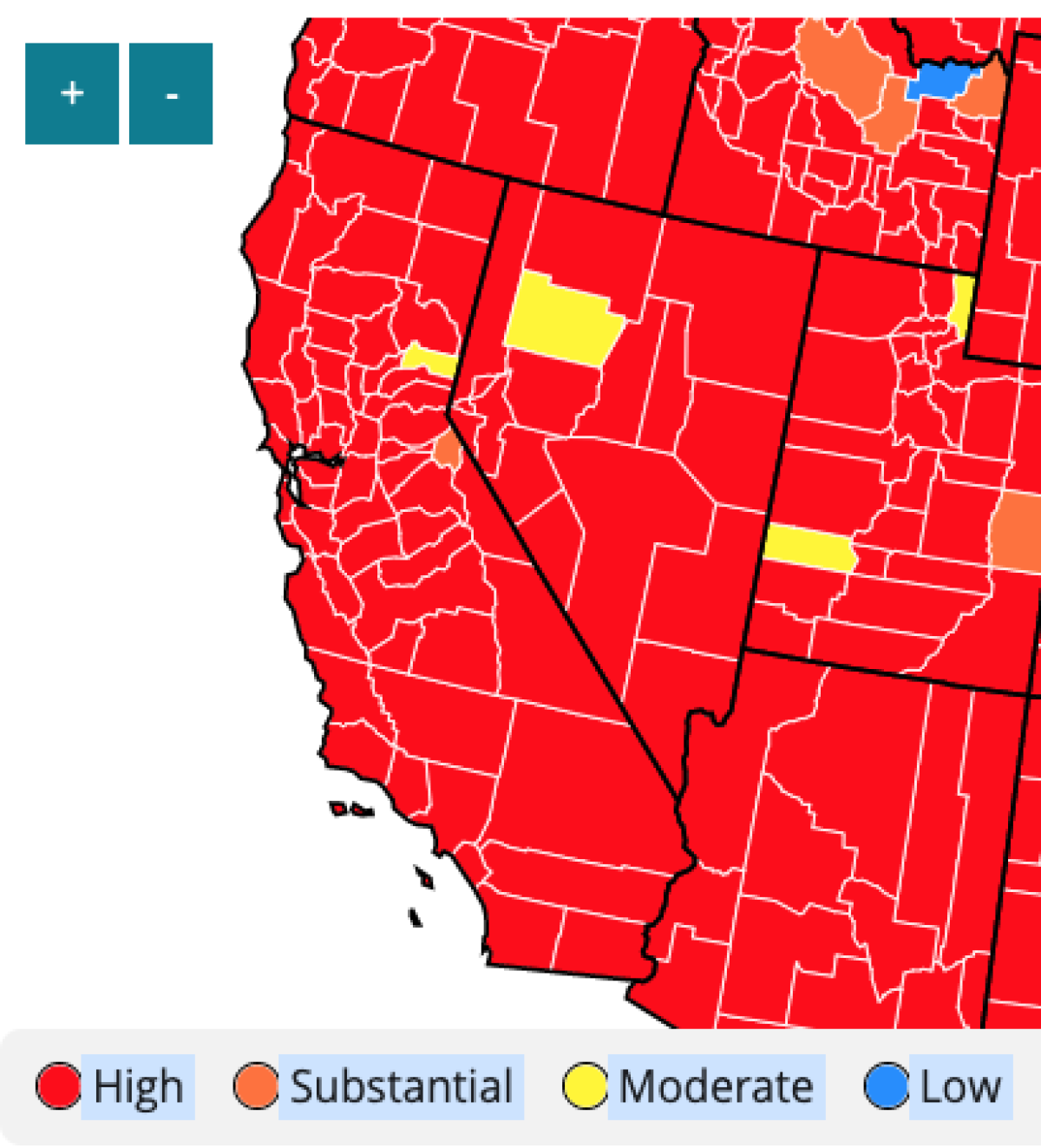
On Wednesday, 7,271 coronavirus-positive patients were hospitalized statewide — less than half of the Omicron-era peak of 15,435, which was recorded Jan. 21.
Deaths, the final devastating indicator of coronavirus spread, remain high, however. More than 1,500 Californians have died from COVID-19 in just the last week, pushing the pandemic’s total toll to nearly 82,600.
Seven out of 10 Californians are already fully vaccinated, according to data compiled by The Times. Nearly 70 million total doses have been administered statewide to date.
About one-third of Californians of all ages — more than 13 million residents — have received a booster dose.
The milestone came on Wednesday, when 102 deaths were reported, the second-highest daily death toll recorded in 11 months.
It would be unwise to interpret this fading of the Omicron surge as a time to be “walking away” from COVID-19, or to think the pandemic is over, Newsom said.
“We have all come to understand what was not understood at the beginning of this crisis: That there is no end date. There is not a moment where we declare victory,” Newsom said.
But it is time to move past a constant sense of catastrophe, underscoring how California is better equipped to manage future surges, and to implement a sensible plan to manage unpredictable variants, according to Newsom.
“People are desperate to move past this crisis mode,” Newsom said. “But they also need to know that we have their back. We’re going to keep them safe. And we’re going to stay on top of this — that we’re not walking away from this pandemic and this disease. We’re not walking away from the virus because the virus continues to change and mutate.”
Times staff writer Taryn Luna contributed to this report.
More to Read
Sign up for Essential California
The most important California stories and recommendations in your inbox every morning.
You may occasionally receive promotional content from the Los Angeles Times.
